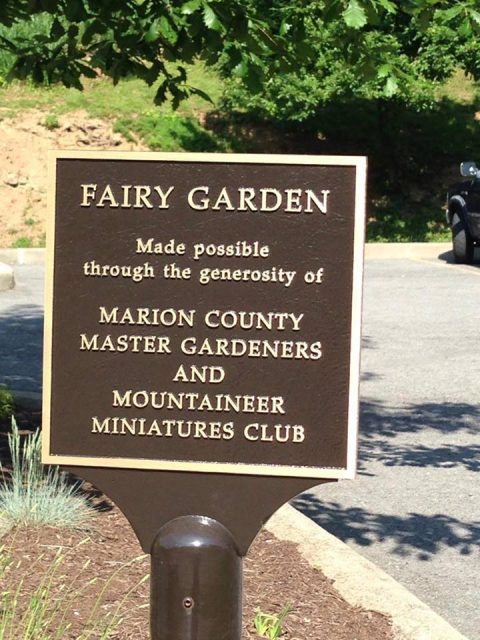Finding Fairies in Marion County
June 1, 2016
Have you ever heard the fluttering of tiny wings or seen a flash of fair gold at the end of a rainbow? Have you ever heard a brownie bantering or a banshee cry?
If you’ve ever nursed a hankerin’ to see the wee folks of the world, stop on by the Frank and Jane Gabor West Virginia Folklife Center at Fairmont State University and see where Marion County folks have created a home for the fairies, and a garden to get people interested in the folklore heritage of our first families.
Fairy Common Beliefs
 According to Pat Musick, interim director at the Folklife Center, every culture that came to land in Marion County had some kind of belief in fairies, including the Native Americans, who used to tell tales of wee little men.
According to Pat Musick, interim director at the Folklife Center, every culture that came to land in Marion County had some kind of belief in fairies, including the Native Americans, who used to tell tales of wee little men.
The strongest beliefs we know of, Musick said, were from the Scots-Irish who came to the county to work the mines and farm the fields.
Musick said while these fairy-believing folk had plenty of foundations for their tales in Ireland, where ratted ruins and ancient tunnels are so common you could trip over them, fairy dwellings may have been scarce in the hills of Marion County.
“For some people, the building of fairy houses might have come with moving away from places that had ready-made ones, like the ancient ruins in Ireland that have all these mysterious doorways that lead into the earth, that were there for centuries— millennia— before the written word came along.”
Those beliefs carried into their traditions, too.
“If immigrants came here and brought their fairy beliefs with them, they aren’t going to take any chances,” she said. “They are going to make homes, where there may not be a home, for the fairies to dwell in, so the fairies won’t try and get in their own homes and cause trouble. It’s another example of extending respect.”
Today, the descendents of those immigrants can recall tales of their own grandmother’s and granddad’s belief in what the wee folks could do.
Fairy Mischievous Fellows
Musick said while there are many different kinds of fairies in Scots- Irish tales, they all seem to share one characteristic— mischief.
Irish tales, they all seem to share one characteristic— mischief.
“Some of them are known for or feared for malevolent mischief. Others are just known for tricky mischief,” she said. “There’s just a lot of lore on how to protect yourself from the milk going sour, or from your child being stolen and being replaced with a changeling. There were beliefs in herbs, rituals and prayers to keep them away.”
This respect for the fairy folk extends far back to even more ancient legends about groups of giants and dwarves and fairies who used to live in Ireland before it was conquered, Musick said.
In a recognition of this forgotten race, building a space for them to live in, leaving out a glass of milk or leaving a tree where it stood were forms of respect to the mythic beings who used to roam the Celtic lands.
Musick said these customs show the immigrants recognized “there is so much more beyond us that we don’t understand.”
Fairy Gracious Folk
 Whichever fairies still roam Marion County have a place to call home again.
Whichever fairies still roam Marion County have a place to call home again.
In 2013, Marion County’s Master Gardeners and the Mountaineer Miniature Club joined forces to make Fairmont State’s Folklife Center Fairy Garden a premier fairy-watching spot in Marion County.
The idea for the garden grew out of a 2011 folklore presentation. The Fairy Garden has been growing ever since.
When you visit the garden, you can see fairy homes, fairy miniatures and plants connected to fairy lore, including some twisted corkscrew hazel. The gardeners picked certain plants and plant colors to attract the fairies who could call the garden home.
The members of these clubs are still adding to the garden, so this fairy adventure spot constantly contains the latest fairy colonization.
Fairy Family Adventures
Musick and the staff at the Folklife Center hope the garden inspires  the whole family to explore the exciting world of West Virginia folklore.
the whole family to explore the exciting world of West Virginia folklore.
“I would like very much for it to be part of the outreach of the celebration of folklore and the awareness of folklore,” she said. “Part of what we do here is encouraging people to tell their stories, or invite their elders to tell their stories, and collect those stories.
“So if someone becomes interested in the fairy garden and says [her] grandmother used to talk about this, or ‘you should really have this kind of being’… Its location at the Folklife Center is hopefully not just a place that has interesting miniatures in it, but is hopefully representative of this whole aspect of folklore that all the cultures share.”
So if you want to combine a fun adventure with West Virginia folklore, why not take a trip to the Fairy Garden?
You can also stop by the Marion County Public Library for a book of fairy stories to read, or you can fairy-watch at one of Marion County’s wild and wonderful parks.
Once you’ve educated yourself on fairy lore at the Folklife Center, let the kids paint their own fairy miniature at Mountain Creative and think about investing a summer’s worth of fairy fun into creating your own fairy home!
Remember, no matter where in Marion County you visit this summer, keep an eye open for the wee folk!

